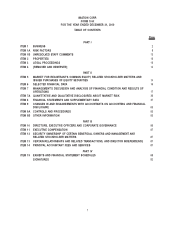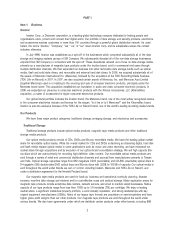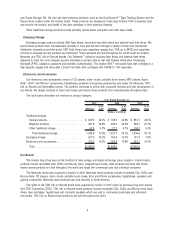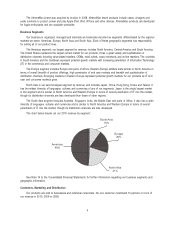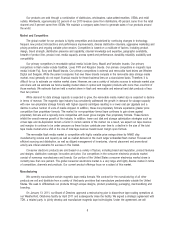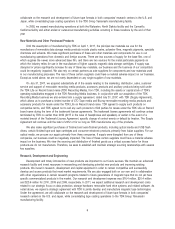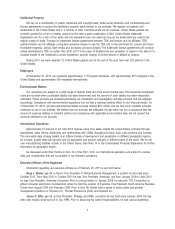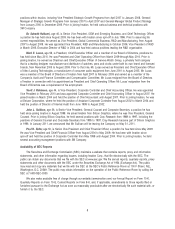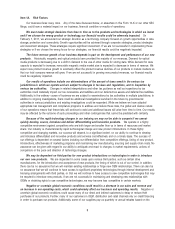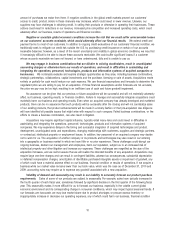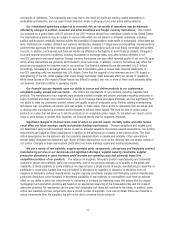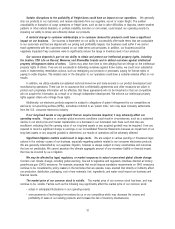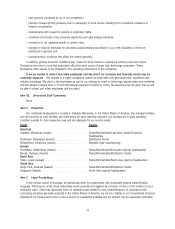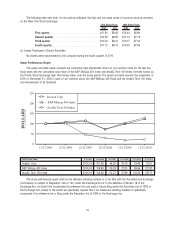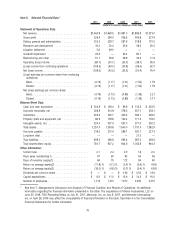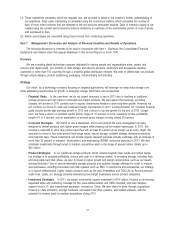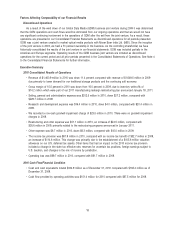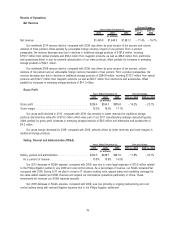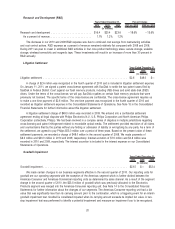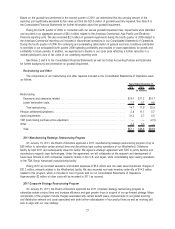Memorex 2010 Annual Report Download - page 14
Download and view the complete annual report
Please find page 14 of the 2010 Memorex annual report below. You can navigate through the pages in the report by either clicking on the pages listed below, or by using the keyword search tool below to find specific information within the annual report.and results of operations. This seasonality also may lead to the need for significant working capital investments in
receivables and inventory and our need to build inventory levels in advance of our most active selling seasons.
Our international operations subject us to economic risk as our results of operations may be adversely
affected by changes in political, economic and other conditions and foreign currency fluctuations. We conduct
our business on a global basis, with 57 percent of our 2010 revenue derived from operations outside of the United States.
Our international operations may be subject to various risks which are not present in domestic operations, including
political and economic instability, terrorist activity, the possibility of expropriation, trade tariffs or embargoes, unfavorable tax
laws, restrictions on royalties, dividend and currency remittances, changes in foreign laws and regulations, requirements for
governmental approvals for new ventures and local participation in operations such as local equity ownership and workers’
councils. In addition, our business and financial results are affected by fluctuations in world financial markets. Changes in
local and regional economic conditions, including fluctuations in exchange rates, may affect product demand in our
non-U.S. operations and export markets. Foreign currency fluctuations can also affect reported profits of our non-U.S. oper-
ations where transactions are generally denominated in local currencies. In addition, currency fluctuations may affect the
prices we pay suppliers for materials used in our products. Our financial statements are denominated in U.S. dollars.
Accordingly, fluctuations in exchange rates may give rise to translation gains or losses when financial statements of
non-U.S. operating units are translated into U.S. dollars. Given that the majority of our revenues are non-U.S. based, a
strengthening of the U.S. dollar against other major foreign currencies could adversely affect our results of operations.
While these factors or the impact of these factors are difficult to predict, any one or more of them could adversely affect
our business, financial condition or operating results.
Our financial success depends upon our ability to source and deliver products to our customers at
acceptable quality, volume and cost levels. We source the manufacture of our products, including magnetic tape
products. The manufacture of our magnetic tape products involves complex and precise processes requiring production in
highly controlled and clean room environments. If we do not manage these processes effectively, we may significantly hurt
our ability to meet our customers’ product volume and quality needs at acceptable costs. Further, existing manufacturing
techniques may not achieve our volume and cost targets. In these cases, there can be no assurance that we will be able
to develop new manufacturing processes and techniques to achieve these targets. We must be able to obtain quality
products at a price that will allow us to sell the products at an acceptable gross margin. To the extent we cannot control
costs or price erosion is greater than expected, our financial results may be negatively impacted.
Significant changes in discount rates, rates of return on pension assets, mortality tables and other factors
could affect our future earnings, equity and pension funding requirements. Pension obligations and related costs
are determined using actual investment results as well as actuarial valuations that involve several assumptions. Our funding
requirements are based on these assumptions in addition to the performance of assets in the pension plans. The most
critical assumptions are the discount rate, the long-term expected return on assets and mortality. Other assumptions
include salary increases and retirement age. Some of these assumptions, such as the discount rate, are largely outside of
our control. Changes in these assumptions could affect our future earnings, equity and funding requirements.
We use a variety of raw materials, supplier-provided parts, components, sub-systems and third-party contract
manufacturing services in our businesses and significant shortages, supplier capacity constraints, supplier
production disruptions or price increases could increase our operating costs and adversely impact the
competitive positions of our products. Our reliance on suppliers, third-party contract manufacturing and commodity
markets to secure raw materials, parts and components used in our products exposes us to volatility in the prices and
availability of these materials. In some instances, we depend upon a single source of supply, manufacturing or assembly or
participate in commodity markets that may be subject to allocations by suppliers. A disruption in deliveries from our
suppliers or third-party contract manufacturers, supplier capacity constraints, supplier and third-party contract manufacturer
production disruptions, price increases or decreased availability of raw materials or commodities could have an adverse
effect on our ability to meet our commitments to customers or increase our operating costs. We believe that our supply
management and production practices are based on an appropriate balancing of the foreseeable risks and the costs of
alternative practices. No assurances can be given that acceptable cost levels will continue in the future. In addition, some
critical raw materials and key components have a limited number of suppliers. If we cannot obtain those raw materials or
critical components from the suppliers, we will not be able to produce certain products.
11


